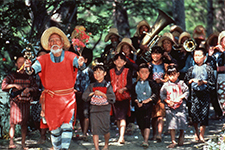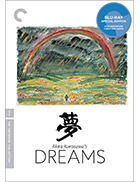Dreams (Yume)
|  Akira Kurosawa’s antepenultimate film Dreams is quite unlike any of the revered Japanese auteur’s previous works, although it shares some characteristics with Dodes’ka-den (1970), his first color film, which interwove a loosely connected group of stories that all took place in a slum on the outskirts of Tokyo. Dreams has a similar kind of narrative logic in that it is an assemblage of eight stories, although all of them take the form of dreams and have entirely different thematic goals and aesthetic designs. They are loosely joined together by a recurring character/dreamer referred to in some of the credits as “I” (a filmic stand-in for Kurosawa, who based his screenplay on his own dreams and memories), who we see in each dream as a small child (Akira Terao), as a young boy (Toshihiko Nakano), as an adolescent (Mitsunori Isaki), and in varying stages of adulthood. The film’s title is appropriate because nothing takes place outside the dreaming world; there is no waking, no reality—only the dreams themselves, each of which is presented as a slice of oneiric experience with varying degrees of fantasy, wish fulfillment, horror, and regret. Originally trained as a painter, Kurosawa was always an enormously visually inventive director who was willing to bend and break rules, experiment with convention, and mix traits of Eastern and Western cinema to suit his needs. Many of his films could be described as “painterly,” especially once he shifted to color after 1970, but Dreams is arguably his most painterly cinematic achievement, partially because he is completely unrestrained by both the requirements of a beginning-to-end narrative structure (thus everything takes on symbolic and metaphoric, rather than narrative, value) and the physical rules of the “real” world. As the entirety of the film takes place within various dreams, he is free to explore visual representation in whatever manner he wants, resulting in some of the most gorgeous imagery of his lengthy career. There is replete with unforgettable moments such as “I” disappearing into an enormous field of flowers that is flanked in the sky by a rainbow, a steep grassy hill that is suddenly covered with blossoming peach trees, a vicious blizzard that gives rise to a snowbound spirit, the ghostly specter of an entire platoon that was wiped out during the war, a world suddenly rendered as Vincent Van Gogh paintings, and a nuclear reactor in melt-down setting off atomic explosions around Mount Fuji, which is depicted with purposefully antiquated special effects that make it feel like outtakes from a marauding monster movie (not surprisingly, Gojira director Ishirô Honda is credited as an assistant director). As with any anthology film, Dreams is somewhat uneven, with some segments registering with more emotional, visual, and symbolic power than others. Interestingly, the segments that tend to work the best are the ones that are most clearly indebted to the Japanese horror tradition, an aspect of cinema that Kurosawa had rarely integrated into his films (although he was certainly responsible for helping to increase the visual presence of graphic bloodshed in world cinema with his early ’60s samurai films Yojimbo and Sanjuro). The Yuki-onna (spirit woman) in “The Blizzard” sequence who tries to lure a mountain climber into sleep and therefore death is memorably creepy, while the blue-faced soldier ghosts in “The Tunnel” create a genuine sense of despair at the futility of war and the high human cost of Japan’s imperialism. The exploding reactors and subsequent terror in “Mount Fuji in Red” is an evocative, self-conscious means of conveying the era’s deep-seated nuclear fears, which is also the central theme of “The Weeping Demon,” which depicts a post-nuclear apocalyptic landscape dotted with enormous dandelions and one-horned human survivors suffering in terrible agony. At the same time, though, the film is filled with images of ravishing beauty and hope. “Crows,” the segment in which the world turns into various Van Gogh paintings, is a true artist’s delight, while “Village of the Watermills” concludes the film on a sense of idyllic togetherness. As with his two previous films, the samurai epics Kagemusha (1980) and Ran (1985), Dreams was partially enabled by American filmmakers who had been inspired by Kurosawa’s works when they were film students in the 1960s and wanted to help extend his career (by the end of the 1970s he could no longer get work in Japan). In this case, Steven Spielberg and his production company Amblin Entertainment served as “presenter,” helping to secure worldwide distribution by Warner Bros., while George Lucas secured the services of his effects house Industrial Light & Magic to produce the Van Gogh effects and Martin Scorsese appears on-screen as Van Gogh (with his hair and beard dyed red, he looks remarkably similar to the painter). The result is a film that, while not necessarily among Kurosawa’s best, is still a remarkable achievement that draws you deep into its fantastical world; even the least effective bits still work in their own way. Having lived through a great deal of adversity both personally and professionally, Kurosawa clearly felt a great connection with the stories in Dreams, and it will remain a lasting testament to his visual ingenuity and his sincere concern about the world.
Copyright © 2016 James Kendrick Thoughts? E-mail James Kendrick All images copyright © The Criterion Collection / Warner Bros. | |||||||||||||||||||||||||||||||||||
Overall Rating: 

 (3)
(3)


